MGT5OBR Group Report: Analyzing Motivation, Diversity, and Leadership
VerifiedAdded on 2022/12/22
|7
|1604
|1
Report
AI Summary
This report delves into the critical aspects of organizational behavior, focusing on motivation, workforce diversity, and leadership. It begins by defining motivation, highlighting its psychological underpinnings and various influencing factors, including recognition, job satisfaction, teamwork, and financial aspirations. The report then explores five key motivational theories: Maslow's Hierarchy of Needs, Herzberg's Two-factor theory, Hawthorne Effect, Expectancy Theory, and Three Dimensional Theory of Attribution. It provides an in-depth analysis of Maslow's Hierarchy, detailing the five stages of needs: physiological, safety, love and belongingness, esteem, and self-actualization. The report also examines the impact of workforce diversity, addressing challenges and offering insights into effective management strategies. Additionally, the report looks at the role of leadership in fostering a motivated and productive work environment. Finally, it emphasizes the importance of productivity as a result of combined efficiency and effectiveness within the organization, particularly highlighting the significance of human resource management in achieving optimal output.
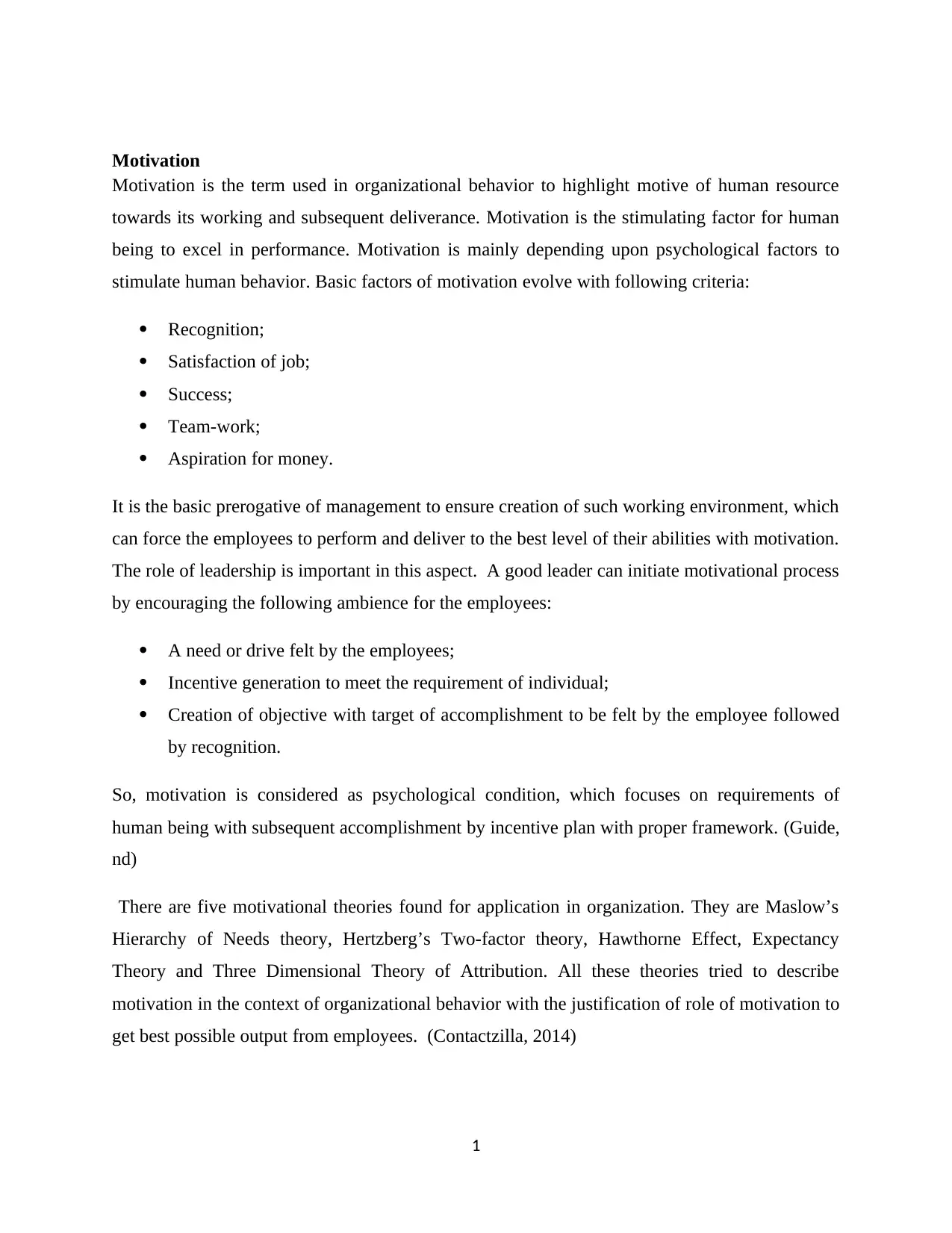
Motivation
Motivation is the term used in organizational behavior to highlight motive of human resource
towards its working and subsequent deliverance. Motivation is the stimulating factor for human
being to excel in performance. Motivation is mainly depending upon psychological factors to
stimulate human behavior. Basic factors of motivation evolve with following criteria:
Recognition;
Satisfaction of job;
Success;
Team-work;
Aspiration for money.
It is the basic prerogative of management to ensure creation of such working environment, which
can force the employees to perform and deliver to the best level of their abilities with motivation.
The role of leadership is important in this aspect. A good leader can initiate motivational process
by encouraging the following ambience for the employees:
A need or drive felt by the employees;
Incentive generation to meet the requirement of individual;
Creation of objective with target of accomplishment to be felt by the employee followed
by recognition.
So, motivation is considered as psychological condition, which focuses on requirements of
human being with subsequent accomplishment by incentive plan with proper framework. (Guide,
nd)
There are five motivational theories found for application in organization. They are Maslow’s
Hierarchy of Needs theory, Hertzberg’s Two-factor theory, Hawthorne Effect, Expectancy
Theory and Three Dimensional Theory of Attribution. All these theories tried to describe
motivation in the context of organizational behavior with the justification of role of motivation to
get best possible output from employees. (Contactzilla, 2014)
1
Motivation is the term used in organizational behavior to highlight motive of human resource
towards its working and subsequent deliverance. Motivation is the stimulating factor for human
being to excel in performance. Motivation is mainly depending upon psychological factors to
stimulate human behavior. Basic factors of motivation evolve with following criteria:
Recognition;
Satisfaction of job;
Success;
Team-work;
Aspiration for money.
It is the basic prerogative of management to ensure creation of such working environment, which
can force the employees to perform and deliver to the best level of their abilities with motivation.
The role of leadership is important in this aspect. A good leader can initiate motivational process
by encouraging the following ambience for the employees:
A need or drive felt by the employees;
Incentive generation to meet the requirement of individual;
Creation of objective with target of accomplishment to be felt by the employee followed
by recognition.
So, motivation is considered as psychological condition, which focuses on requirements of
human being with subsequent accomplishment by incentive plan with proper framework. (Guide,
nd)
There are five motivational theories found for application in organization. They are Maslow’s
Hierarchy of Needs theory, Hertzberg’s Two-factor theory, Hawthorne Effect, Expectancy
Theory and Three Dimensional Theory of Attribution. All these theories tried to describe
motivation in the context of organizational behavior with the justification of role of motivation to
get best possible output from employees. (Contactzilla, 2014)
1
Paraphrase This Document
Need a fresh take? Get an instant paraphrase of this document with our AI Paraphraser
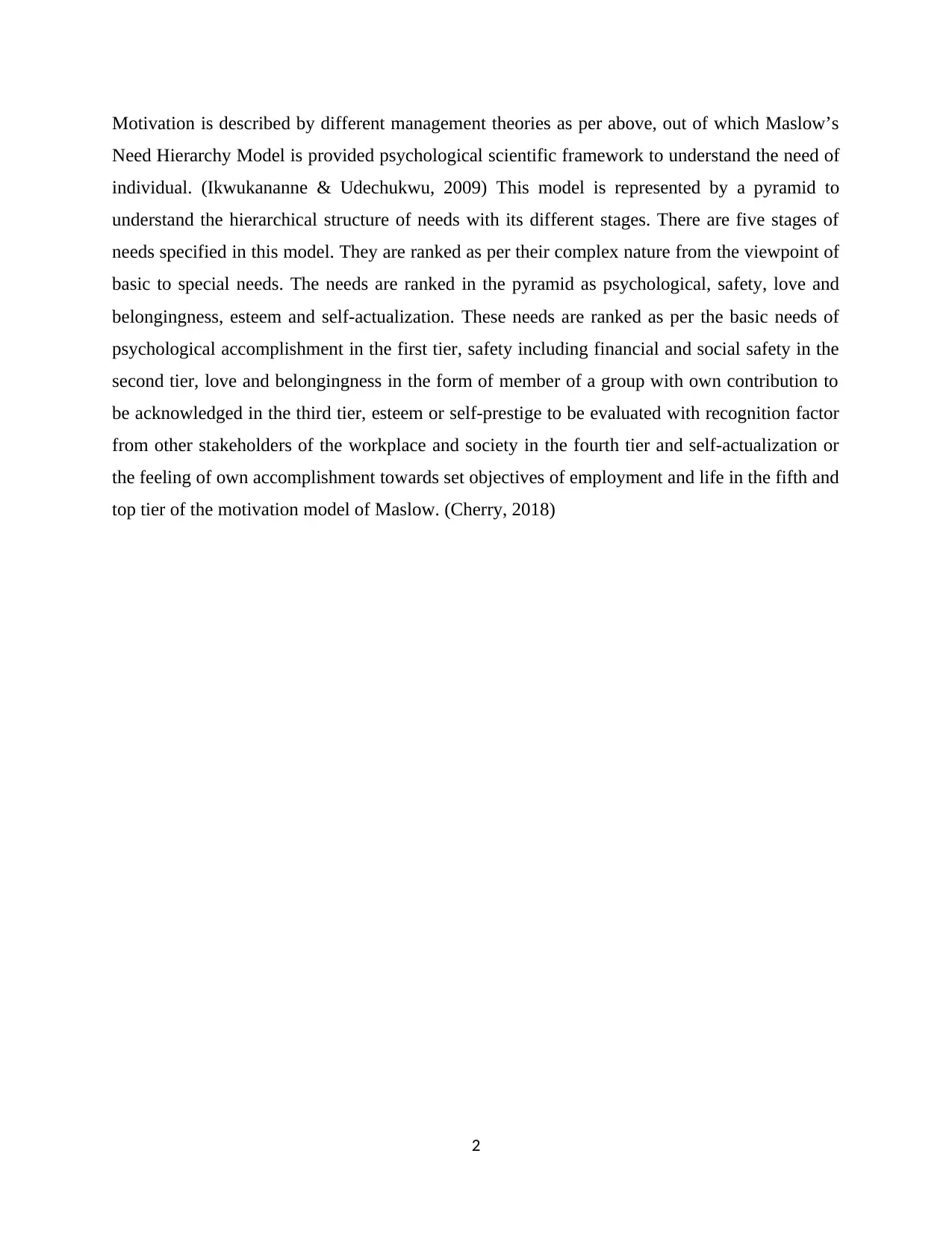
Motivation is described by different management theories as per above, out of which Maslow’s
Need Hierarchy Model is provided psychological scientific framework to understand the need of
individual. (Ikwukananne & Udechukwu, 2009) This model is represented by a pyramid to
understand the hierarchical structure of needs with its different stages. There are five stages of
needs specified in this model. They are ranked as per their complex nature from the viewpoint of
basic to special needs. The needs are ranked in the pyramid as psychological, safety, love and
belongingness, esteem and self-actualization. These needs are ranked as per the basic needs of
psychological accomplishment in the first tier, safety including financial and social safety in the
second tier, love and belongingness in the form of member of a group with own contribution to
be acknowledged in the third tier, esteem or self-prestige to be evaluated with recognition factor
from other stakeholders of the workplace and society in the fourth tier and self-actualization or
the feeling of own accomplishment towards set objectives of employment and life in the fifth and
top tier of the motivation model of Maslow. (Cherry, 2018)
2
Need Hierarchy Model is provided psychological scientific framework to understand the need of
individual. (Ikwukananne & Udechukwu, 2009) This model is represented by a pyramid to
understand the hierarchical structure of needs with its different stages. There are five stages of
needs specified in this model. They are ranked as per their complex nature from the viewpoint of
basic to special needs. The needs are ranked in the pyramid as psychological, safety, love and
belongingness, esteem and self-actualization. These needs are ranked as per the basic needs of
psychological accomplishment in the first tier, safety including financial and social safety in the
second tier, love and belongingness in the form of member of a group with own contribution to
be acknowledged in the third tier, esteem or self-prestige to be evaluated with recognition factor
from other stakeholders of the workplace and society in the fourth tier and self-actualization or
the feeling of own accomplishment towards set objectives of employment and life in the fifth and
top tier of the motivation model of Maslow. (Cherry, 2018)
2
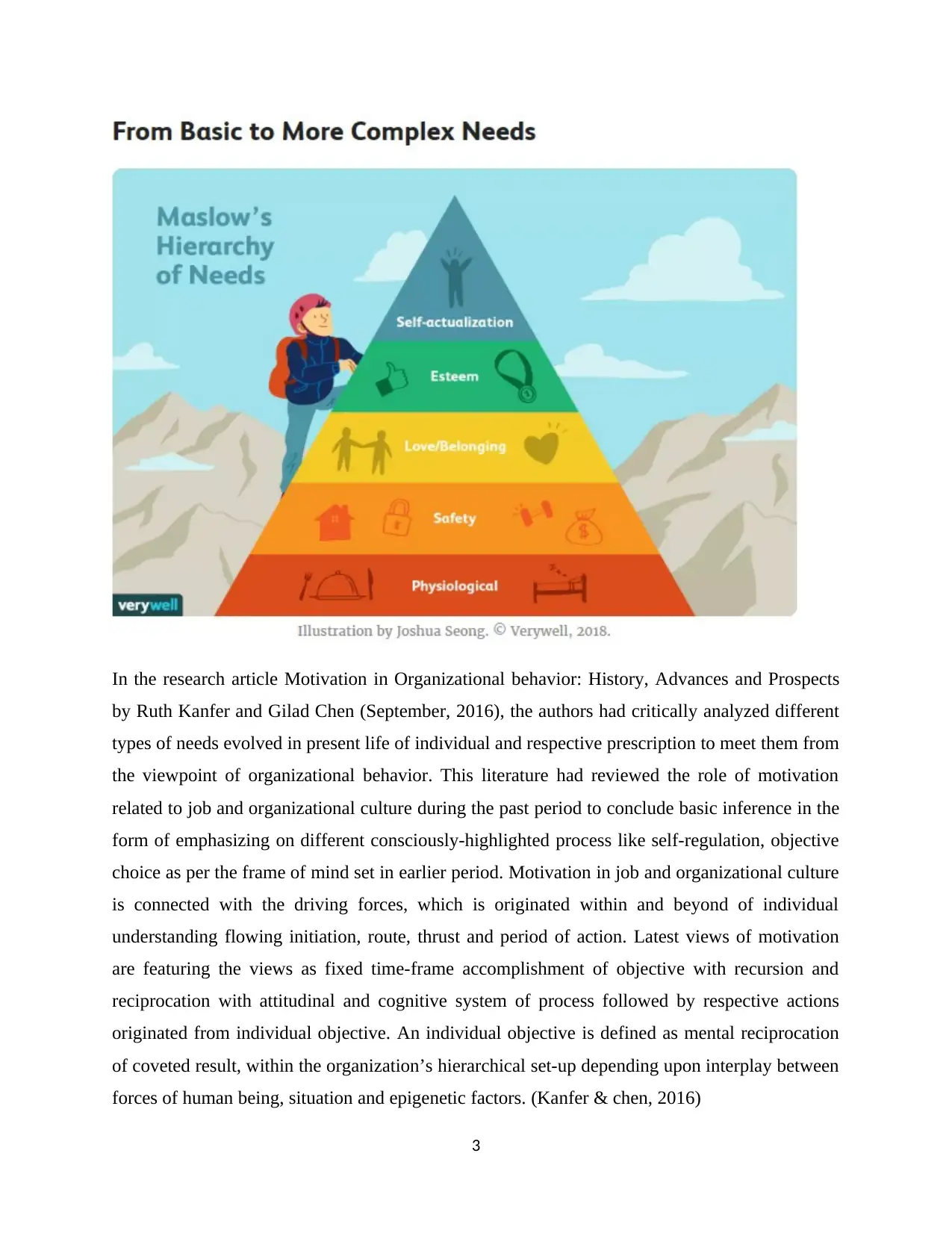
In the research article Motivation in Organizational behavior: History, Advances and Prospects
by Ruth Kanfer and Gilad Chen (September, 2016), the authors had critically analyzed different
types of needs evolved in present life of individual and respective prescription to meet them from
the viewpoint of organizational behavior. This literature had reviewed the role of motivation
related to job and organizational culture during the past period to conclude basic inference in the
form of emphasizing on different consciously-highlighted process like self-regulation, objective
choice as per the frame of mind set in earlier period. Motivation in job and organizational culture
is connected with the driving forces, which is originated within and beyond of individual
understanding flowing initiation, route, thrust and period of action. Latest views of motivation
are featuring the views as fixed time-frame accomplishment of objective with recursion and
reciprocation with attitudinal and cognitive system of process followed by respective actions
originated from individual objective. An individual objective is defined as mental reciprocation
of coveted result, within the organization’s hierarchical set-up depending upon interplay between
forces of human being, situation and epigenetic factors. (Kanfer & chen, 2016)
3
by Ruth Kanfer and Gilad Chen (September, 2016), the authors had critically analyzed different
types of needs evolved in present life of individual and respective prescription to meet them from
the viewpoint of organizational behavior. This literature had reviewed the role of motivation
related to job and organizational culture during the past period to conclude basic inference in the
form of emphasizing on different consciously-highlighted process like self-regulation, objective
choice as per the frame of mind set in earlier period. Motivation in job and organizational culture
is connected with the driving forces, which is originated within and beyond of individual
understanding flowing initiation, route, thrust and period of action. Latest views of motivation
are featuring the views as fixed time-frame accomplishment of objective with recursion and
reciprocation with attitudinal and cognitive system of process followed by respective actions
originated from individual objective. An individual objective is defined as mental reciprocation
of coveted result, within the organization’s hierarchical set-up depending upon interplay between
forces of human being, situation and epigenetic factors. (Kanfer & chen, 2016)
3
⊘ This is a preview!⊘
Do you want full access?
Subscribe today to unlock all pages.

Trusted by 1+ million students worldwide
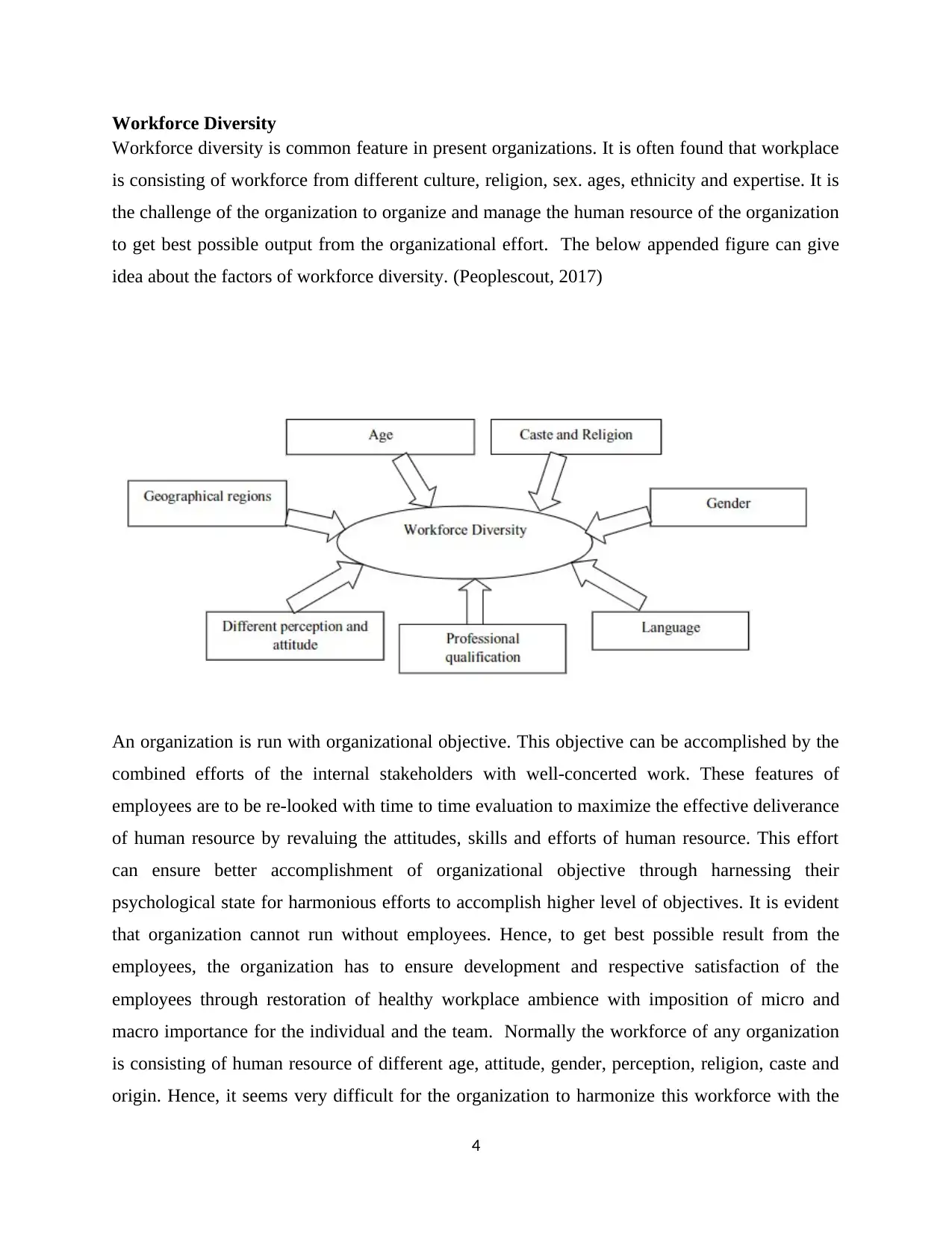
Workforce Diversity
Workforce diversity is common feature in present organizations. It is often found that workplace
is consisting of workforce from different culture, religion, sex. ages, ethnicity and expertise. It is
the challenge of the organization to organize and manage the human resource of the organization
to get best possible output from the organizational effort. The below appended figure can give
idea about the factors of workforce diversity. (Peoplescout, 2017)
An organization is run with organizational objective. This objective can be accomplished by the
combined efforts of the internal stakeholders with well-concerted work. These features of
employees are to be re-looked with time to time evaluation to maximize the effective deliverance
of human resource by revaluing the attitudes, skills and efforts of human resource. This effort
can ensure better accomplishment of organizational objective through harnessing their
psychological state for harmonious efforts to accomplish higher level of objectives. It is evident
that organization cannot run without employees. Hence, to get best possible result from the
employees, the organization has to ensure development and respective satisfaction of the
employees through restoration of healthy workplace ambience with imposition of micro and
macro importance for the individual and the team. Normally the workforce of any organization
is consisting of human resource of different age, attitude, gender, perception, religion, caste and
origin. Hence, it seems very difficult for the organization to harmonize this workforce with the
4
Workforce diversity is common feature in present organizations. It is often found that workplace
is consisting of workforce from different culture, religion, sex. ages, ethnicity and expertise. It is
the challenge of the organization to organize and manage the human resource of the organization
to get best possible output from the organizational effort. The below appended figure can give
idea about the factors of workforce diversity. (Peoplescout, 2017)
An organization is run with organizational objective. This objective can be accomplished by the
combined efforts of the internal stakeholders with well-concerted work. These features of
employees are to be re-looked with time to time evaluation to maximize the effective deliverance
of human resource by revaluing the attitudes, skills and efforts of human resource. This effort
can ensure better accomplishment of organizational objective through harnessing their
psychological state for harmonious efforts to accomplish higher level of objectives. It is evident
that organization cannot run without employees. Hence, to get best possible result from the
employees, the organization has to ensure development and respective satisfaction of the
employees through restoration of healthy workplace ambience with imposition of micro and
macro importance for the individual and the team. Normally the workforce of any organization
is consisting of human resource of different age, attitude, gender, perception, religion, caste and
origin. Hence, it seems very difficult for the organization to harmonize this workforce with the
4
Paraphrase This Document
Need a fresh take? Get an instant paraphrase of this document with our AI Paraphraser
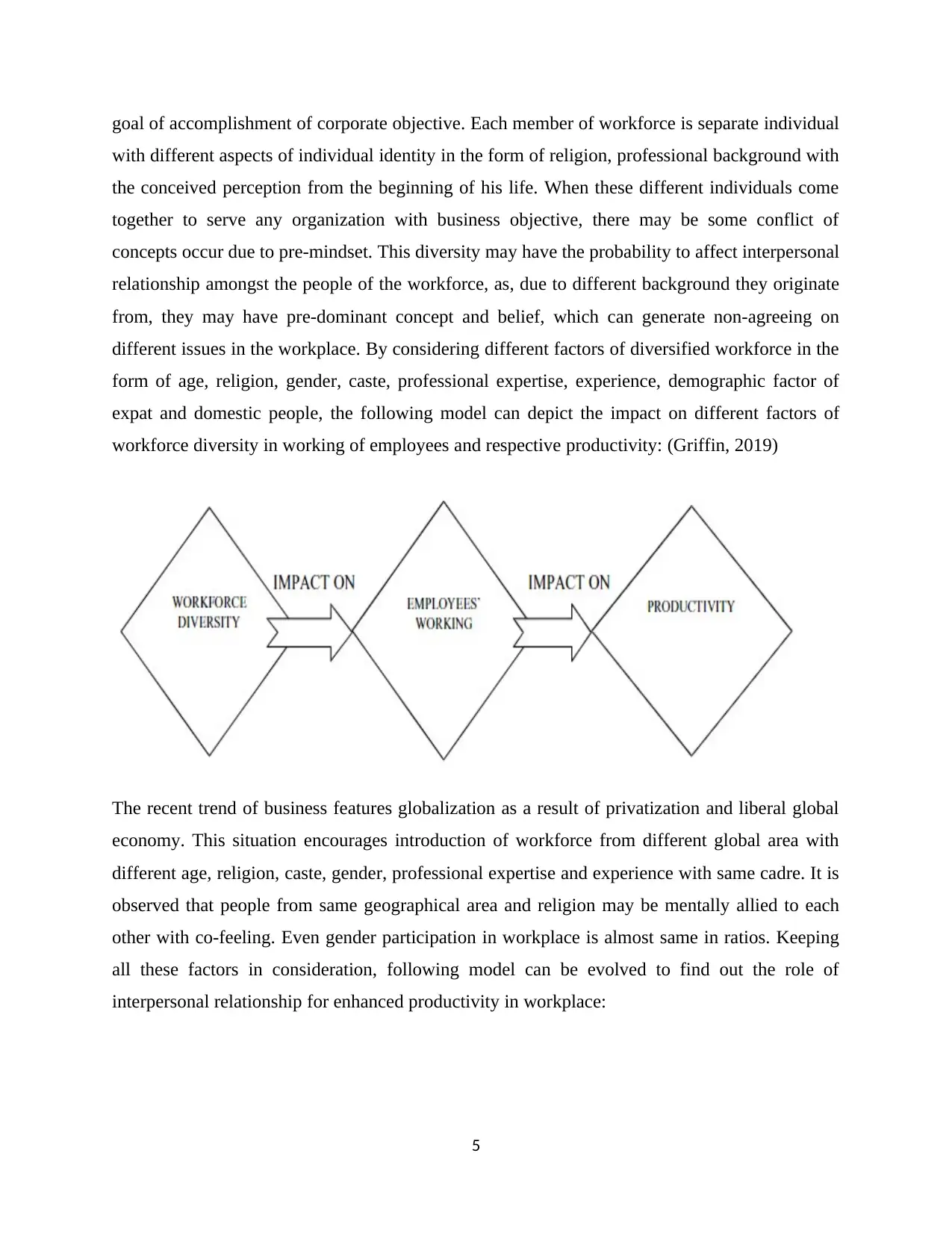
goal of accomplishment of corporate objective. Each member of workforce is separate individual
with different aspects of individual identity in the form of religion, professional background with
the conceived perception from the beginning of his life. When these different individuals come
together to serve any organization with business objective, there may be some conflict of
concepts occur due to pre-mindset. This diversity may have the probability to affect interpersonal
relationship amongst the people of the workforce, as, due to different background they originate
from, they may have pre-dominant concept and belief, which can generate non-agreeing on
different issues in the workplace. By considering different factors of diversified workforce in the
form of age, religion, gender, caste, professional expertise, experience, demographic factor of
expat and domestic people, the following model can depict the impact on different factors of
workforce diversity in working of employees and respective productivity: (Griffin, 2019)
The recent trend of business features globalization as a result of privatization and liberal global
economy. This situation encourages introduction of workforce from different global area with
different age, religion, caste, gender, professional expertise and experience with same cadre. It is
observed that people from same geographical area and religion may be mentally allied to each
other with co-feeling. Even gender participation in workplace is almost same in ratios. Keeping
all these factors in consideration, following model can be evolved to find out the role of
interpersonal relationship for enhanced productivity in workplace:
5
with different aspects of individual identity in the form of religion, professional background with
the conceived perception from the beginning of his life. When these different individuals come
together to serve any organization with business objective, there may be some conflict of
concepts occur due to pre-mindset. This diversity may have the probability to affect interpersonal
relationship amongst the people of the workforce, as, due to different background they originate
from, they may have pre-dominant concept and belief, which can generate non-agreeing on
different issues in the workplace. By considering different factors of diversified workforce in the
form of age, religion, gender, caste, professional expertise, experience, demographic factor of
expat and domestic people, the following model can depict the impact on different factors of
workforce diversity in working of employees and respective productivity: (Griffin, 2019)
The recent trend of business features globalization as a result of privatization and liberal global
economy. This situation encourages introduction of workforce from different global area with
different age, religion, caste, gender, professional expertise and experience with same cadre. It is
observed that people from same geographical area and religion may be mentally allied to each
other with co-feeling. Even gender participation in workplace is almost same in ratios. Keeping
all these factors in consideration, following model can be evolved to find out the role of
interpersonal relationship for enhanced productivity in workplace:
5
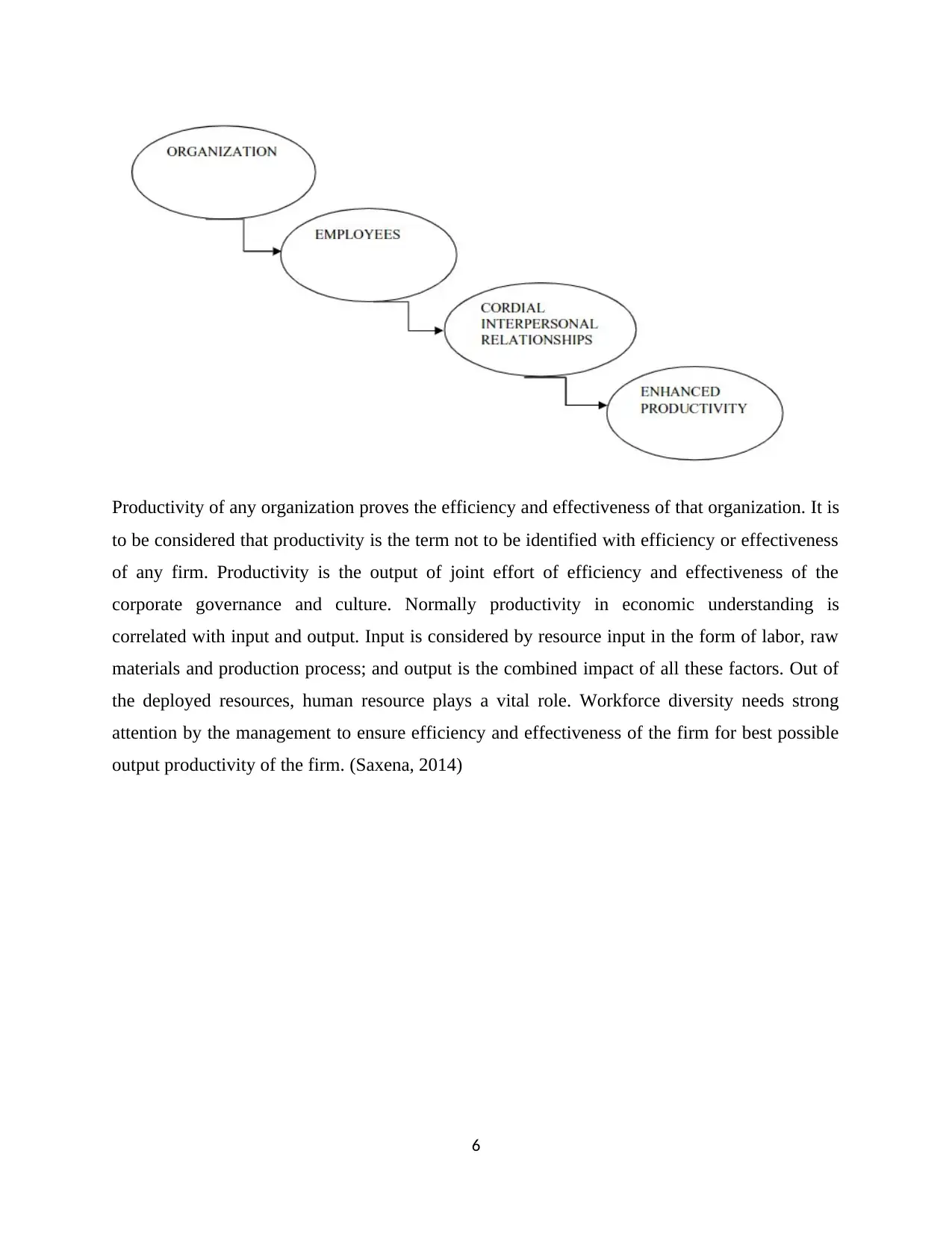
Productivity of any organization proves the efficiency and effectiveness of that organization. It is
to be considered that productivity is the term not to be identified with efficiency or effectiveness
of any firm. Productivity is the output of joint effort of efficiency and effectiveness of the
corporate governance and culture. Normally productivity in economic understanding is
correlated with input and output. Input is considered by resource input in the form of labor, raw
materials and production process; and output is the combined impact of all these factors. Out of
the deployed resources, human resource plays a vital role. Workforce diversity needs strong
attention by the management to ensure efficiency and effectiveness of the firm for best possible
output productivity of the firm. (Saxena, 2014)
6
to be considered that productivity is the term not to be identified with efficiency or effectiveness
of any firm. Productivity is the output of joint effort of efficiency and effectiveness of the
corporate governance and culture. Normally productivity in economic understanding is
correlated with input and output. Input is considered by resource input in the form of labor, raw
materials and production process; and output is the combined impact of all these factors. Out of
the deployed resources, human resource plays a vital role. Workforce diversity needs strong
attention by the management to ensure efficiency and effectiveness of the firm for best possible
output productivity of the firm. (Saxena, 2014)
6
⊘ This is a preview!⊘
Do you want full access?
Subscribe today to unlock all pages.

Trusted by 1+ million students worldwide
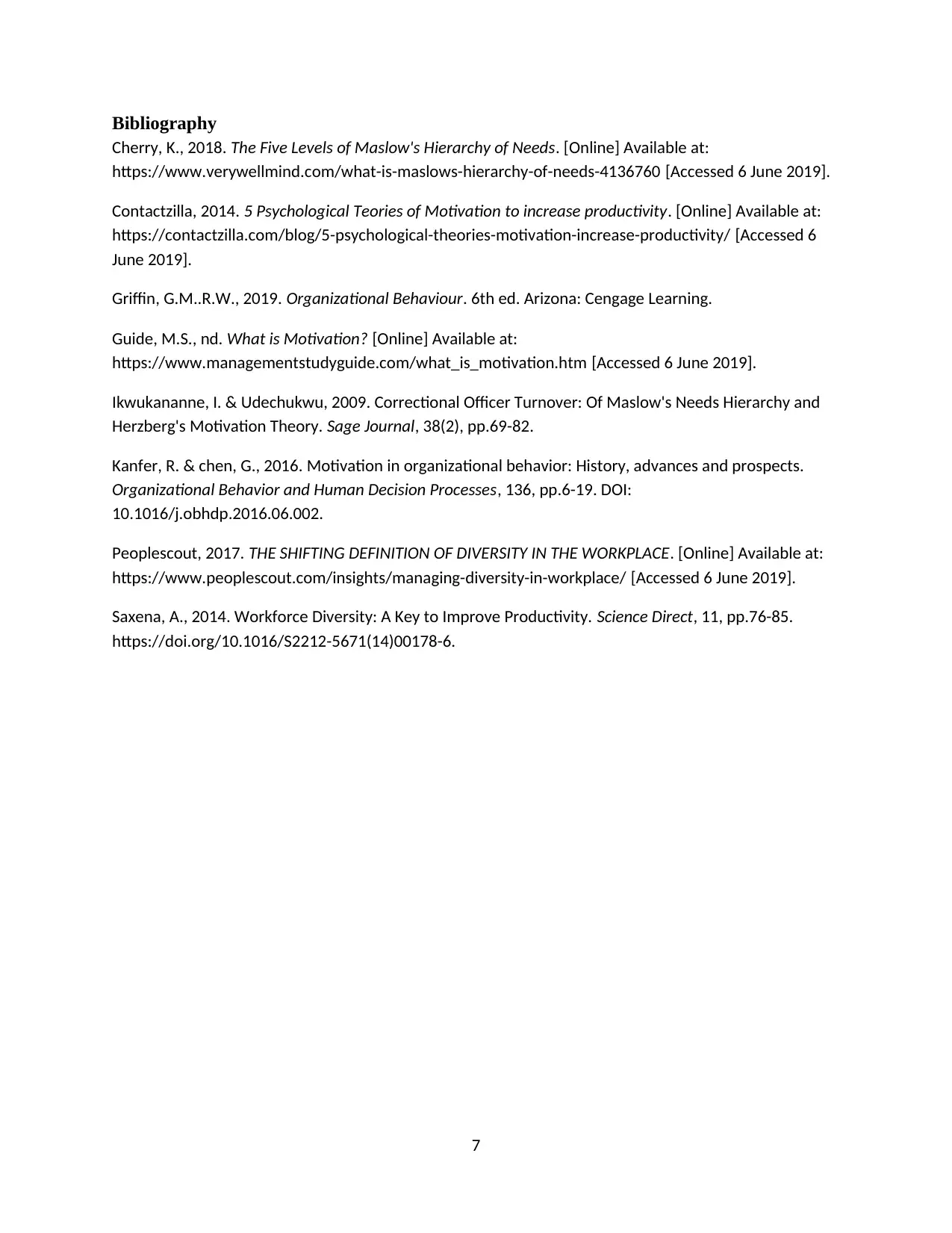
Bibliography
Cherry, K., 2018. The Five Levels of Maslow's Hierarchy of Needs. [Online] Available at:
https://www.verywellmind.com/what-is-maslows-hierarchy-of-needs-4136760 [Accessed 6 June 2019].
Contactzilla, 2014. 5 Psychological Teories of Motivation to increase productivity. [Online] Available at:
https://contactzilla.com/blog/5-psychological-theories-motivation-increase-productivity/ [Accessed 6
June 2019].
Griffin, G.M..R.W., 2019. Organizational Behaviour. 6th ed. Arizona: Cengage Learning.
Guide, M.S., nd. What is Motivation? [Online] Available at:
https://www.managementstudyguide.com/what_is_motivation.htm [Accessed 6 June 2019].
Ikwukananne, I. & Udechukwu, 2009. Correctional Officer Turnover: Of Maslow's Needs Hierarchy and
Herzberg's Motivation Theory. Sage Journal, 38(2), pp.69-82.
Kanfer, R. & chen, G., 2016. Motivation in organizational behavior: History, advances and prospects.
Organizational Behavior and Human Decision Processes, 136, pp.6-19. DOI:
10.1016/j.obhdp.2016.06.002.
Peoplescout, 2017. THE SHIFTING DEFINITION OF DIVERSITY IN THE WORKPLACE. [Online] Available at:
https://www.peoplescout.com/insights/managing-diversity-in-workplace/ [Accessed 6 June 2019].
Saxena, A., 2014. Workforce Diversity: A Key to Improve Productivity. Science Direct, 11, pp.76-85.
https://doi.org/10.1016/S2212-5671(14)00178-6.
7
Cherry, K., 2018. The Five Levels of Maslow's Hierarchy of Needs. [Online] Available at:
https://www.verywellmind.com/what-is-maslows-hierarchy-of-needs-4136760 [Accessed 6 June 2019].
Contactzilla, 2014. 5 Psychological Teories of Motivation to increase productivity. [Online] Available at:
https://contactzilla.com/blog/5-psychological-theories-motivation-increase-productivity/ [Accessed 6
June 2019].
Griffin, G.M..R.W., 2019. Organizational Behaviour. 6th ed. Arizona: Cengage Learning.
Guide, M.S., nd. What is Motivation? [Online] Available at:
https://www.managementstudyguide.com/what_is_motivation.htm [Accessed 6 June 2019].
Ikwukananne, I. & Udechukwu, 2009. Correctional Officer Turnover: Of Maslow's Needs Hierarchy and
Herzberg's Motivation Theory. Sage Journal, 38(2), pp.69-82.
Kanfer, R. & chen, G., 2016. Motivation in organizational behavior: History, advances and prospects.
Organizational Behavior and Human Decision Processes, 136, pp.6-19. DOI:
10.1016/j.obhdp.2016.06.002.
Peoplescout, 2017. THE SHIFTING DEFINITION OF DIVERSITY IN THE WORKPLACE. [Online] Available at:
https://www.peoplescout.com/insights/managing-diversity-in-workplace/ [Accessed 6 June 2019].
Saxena, A., 2014. Workforce Diversity: A Key to Improve Productivity. Science Direct, 11, pp.76-85.
https://doi.org/10.1016/S2212-5671(14)00178-6.
7
1 out of 7
Related Documents
Your All-in-One AI-Powered Toolkit for Academic Success.
+13062052269
info@desklib.com
Available 24*7 on WhatsApp / Email
![[object Object]](/_next/static/media/star-bottom.7253800d.svg)
Unlock your academic potential
Copyright © 2020–2025 A2Z Services. All Rights Reserved. Developed and managed by ZUCOL.





